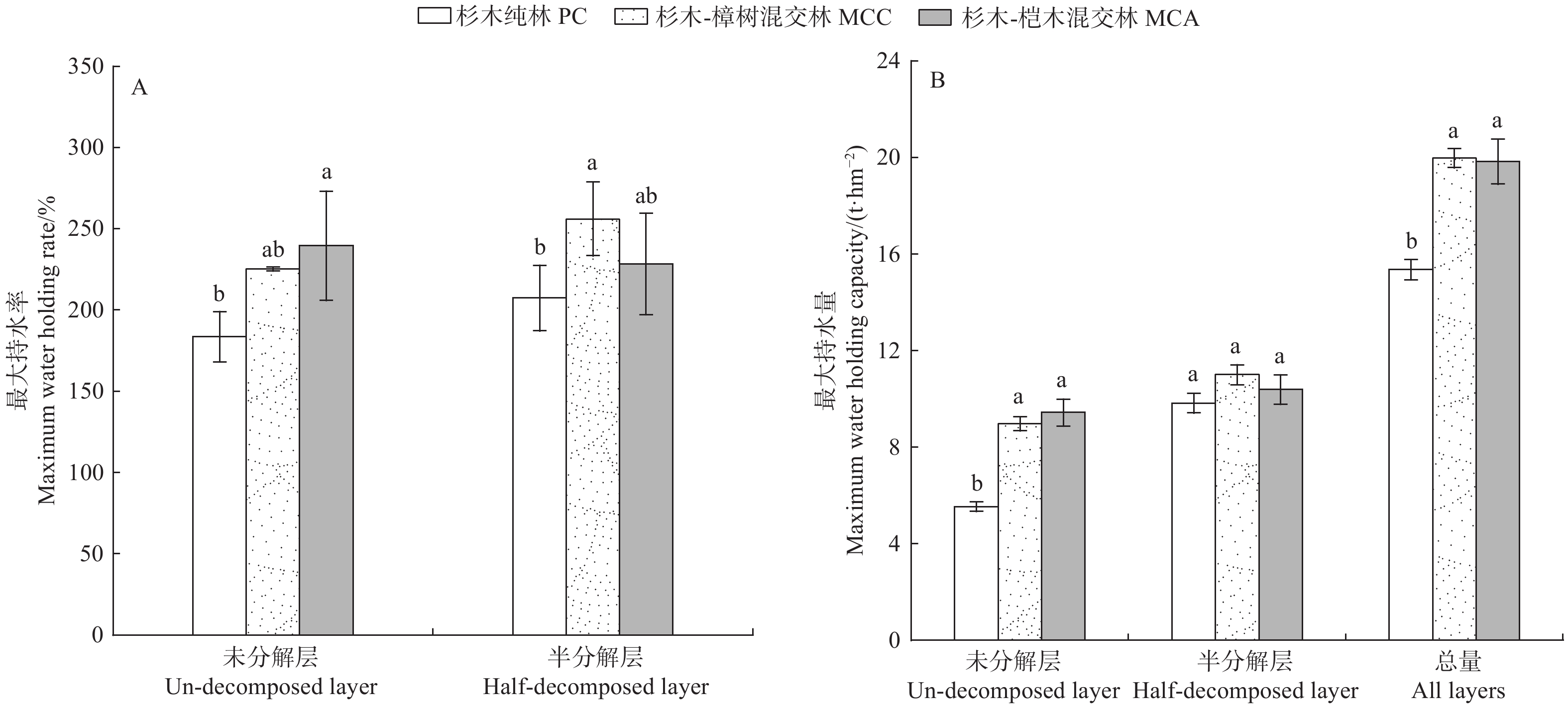-
森林是陆地生态系统的主体和蓄水库,具有保持水土、涵养水源的功能。我国森林水源涵养量约为7.43 × 1010 m3,占全国水源涵养总量的60%以上[1]。凋落物层作为森林涵养水源的第二功能层,不仅可以增加林地地表粗糙度、加快雨水下渗,还能减小降水对地表的溅蚀,降低水分蒸发[2-3]。据前人研究显示,凋落物能吸收相当于自身质量2~5倍的水分,拦蓄的降水超过林地径流量的60%[4-5],这对实现森林截留降水、降低雨水动能和减缓径流产生等水文功能具有重要作用[6]。另一方面,凋落物层还是连接森林植被与土壤的重要媒介,其中凋落物归还和分解过程可促进生态系统养分循环,改善土壤结构,进而增强土壤层涵养水源的能力[7-10]。因此,凋落物层的生态水文效应一直是研究的热点。目前,众多学者对不同区域、不同林分类型的凋落物蓄积量及水文功能进行了研究,如马书国等[11]认为,影响不同林龄杉木(Cunninghamia lanceolata(Lamb.)Hook)人工林凋落物持水量的主要因素为凋落物现存量,且半分解层凋落物的现存量及最大持水量均大于未分解层;秦倩倩等[12]也发现云冷杉针阔混交林半分解层凋落物分解速度快,养分归还量大,持水性和水源涵养等生态功能较好。此外,李伟等[13]发现华南地区6种乡土树种凋落物储量和持水量均表现为米老排(Mytilaria laosensis Lec.) > 火力楠(Michelia macclurei Dandy.) > 樟树(Cinnamomum camphora (L.)Presl.) > 杉木 > 马尾松(Pinus massoniana Lamb.)。可见,由于林分类型、林龄和结构的不同,凋落物的水文效应也存在一定差异。因此,对区域性不同类型人工林凋落物持水特性进行针对性研究,不仅有助于揭示区域环境下其水文功能的差异,而且可为人工林结构优化和可持续经营提供重要参考。
湖南省会同县是我国杉木的中心产区之一,以往对该地区杉木人工林的研究多集中在碳储量[14]、土壤碳氮循环[15]、凋落物分解[16]等方面,而针对不同类型杉木人工林凋落物水文效应的研究较为少见[17]。本研究以湖南会同地区杉木纯林、杉木-樟树混交林、杉木-桤木(Alnus cremastogyne Burk.)混交林3种不同类型杉木人工林为研究对象,通过对其凋落物各分解层组成、储量及持水特性的比较研究,分析不同类型杉木人工林凋落物的生态水文效应和水源涵养功能的差异,为杉木人工林林下生态管理和生态系统服务评估提供科学依据。
-
研究地点位于中国科学院会同森林生态实验站,为湖南省会同县广坪镇的林区(26°05′ N,109°30′ E),地处沅江上游,为云贵高原向江南丘陵过渡地段,海拔为300~600 m,属于典型的亚热带湿润季风气候,年均气温16.5℃,相对湿度30%~90%,年均降水量1200~1400 mm,多集中在4—6月,无霜期300 d左右,地貌为山地中丘陵,土壤类型以黄壤为主[18]。本研究选取的森林类型为1989年秋皆伐后1990年建立的杉木纯林、杉木-樟树混交林和杉木-桤木混交林,杉木与阔叶树的混交比为4:1,造林后各林分管理措施一致,乔木层主要树种为杉木、樟树、桤木;林下灌木层以杜茎山(Maesa japonica (Thunb.)Moritzi.)、火力楠、紫麻(Oreocnide frutescens(Thunb.)Miq.)、木荷(Schima superba Gardn. et Champ.)等为主,林下草本层主要有狗脊蕨(Woodwardia japonica(L.f.) Sm.)、金星蕨(Parathelypteris glanduligera(Kunze.)Ching.)和芒尖苔草(Carex doniana Spreng.)、淡竹叶(Lophatherum gracile Brongn.)等。各研究样地基本概况如表1所示。
林分类型
Forest type海拔
Altitude/m密度
Density/
(stem·hm−2)坡向
Exposure林龄
Age/a平均胸径
Mean DBH/cm平均树高
Average tree height/m主要植物组成
Main plant species杉木纯林 PC 553.1 860~990 SW 29 23.38 16.71 乔木层:杉木
灌木层:杜茎山,绿叶爬山虎,火力楠
草本层:狗脊蕨,菝葜,芒尖苔草,等杉木-樟树混交林 MCC 484.5 850~985 SW 29 24.35 17.70 乔木层:杉木,樟树
灌木层:杜茎山,绿叶爬山虎,紫麻
草本层:狗脊蕨,金星蕨,淡竹叶,等杉木-桤木混交林 MCA 493.8 850~980 SW 29 23.38 18.28 乔木层:杉木,桤木
灌木层:杜茎山,绿叶爬山虎,木荷
草本层:狗脊蕨,金星蕨,粉叶菝葜,等Table 1. Basic characteristics of different plantations
-
2019年8月,在湖南会同生态站选择3种不同林分类型杉木人工林(杉木纯林、杉木-樟树混交林、杉木-桤木混交林)为研究对象,每种林分(研究样地)随机设置3个样方(20 m × 20 m),调查立地因子和林分特征(表1),在各样地内按梅花形分别随机设置5个100 cm × 100 cm的小样方,在每个小样方内沿对角线选取3个点测定各凋落物层厚度,并保持原状按照未分解层(凋落物颜色出现细微变化,枝叶结构基本完整,无分解迹象)、半分解层(凋落物多数已分解破碎,未完全腐烂,肉眼可分辨出枝叶大体形状)收集凋落物[19],随即带回实验室称质量,于85℃下烘干称质量,计算单位面积凋落物现存量。
-
采用浸泡法测定未分解层、半分解层凋落物持水量、持水速率以及持水过程[19]。在保持凋落物原状的条件下,从每个小样方烘干的凋落物样品中称取50 g,装入100目尼龙网袋,分别于吸水0.25、0.5、1、1.5、2、4、6、8、10、12、24 h后取出静置,待无水滴滴下时迅速称质量。根据不同浸水时间凋落物质量变化,计算持水量、吸水速率、最大持水率、拦蓄量和有效拦蓄量等指标[20-21]。
-
运用Microsoft Excel 2013进行数据整理和表格绘制,采用SPSS 20.0软件进行方差分析和回归分析,检验显著性(α = 0.01, 0.05);应用Origin 2018和Sigmaplot 12.5软件作图。
-
由表2可知,凋落物总现存量表现为杉木-桤木混交林 > 杉木-樟树混交林 > 杉木纯林,混交林凋落物现存量显著高于纯林(P < 0.05)。各分解层凋落物现存量在不同林分类型间存在一定差异,其中杉木-樟树混交林和杉木-桤木混交林未分解层凋落物现存量显著高于杉木纯林(P < 0.05);半分解层凋落物现存量在不同林分类型间差异不显著。不同林分类型杉木凋落物未分解层和半分解层占总现存量的比例各不相同,其中杉木-樟树混交林未分解层占总现存量的比例最高,为49.46%,杉木纯林半分解层占总现存量的比例最高,为62.34%,且所有林分类型中半分解层占总现存量的比例均高于未分解层。
林分类型
Forest type总现存量
Total accumulation/
(t·hm−2)未分解层
Undecomposed layer半分解层
Half-decomposed layer现存量
Accumulation/(t·hm−2)占总现存量比例
Ratio/%现存量
Accumulation /(t·hm−2)占总现存量比例
Ratio/%杉木纯林 PC 7.94 ± 0.22 b 2.99 ± 0.46 b 37.65 4.95 ± 0.27 a 62.35 杉木-樟树混交 MCC 8.83 ± 0.17 a 4.37 ± 0.83 ab 49.49 4.46 ± 0.75 a 50.51 杉木-桤木混交 MCA 8.88 ± 0.53 a 4.11 ± 0.55 a 46.28 4.77 ± 1.00 a 53.72 注:同列不同小写字母表示不同林分类型间差异显著(P < 0.05).
Note: Different small letters in the same column meant significant difference at 0.05 level among different stand types.Table 2. Litter characteristics and accumulation of different plantations
-
凋落物持水量与浸水时间的变化如图1所示,在浸水0~4 h内凋落物的持水量迅速增加,尤其是在前0.5 h内吸水量迅速增加,在4~10 h内凋落物持水量增加速率减缓,并逐渐趋于饱和,浸水4 h后,3个林分凋落物的持水量已达1406.00~2080.67 g·kg−1,为最大持水量的75.95%~84.33%,其中不同浸水时间未分解层凋落物持水量均表现为杉木-桤木混交林 > 杉木-樟树混交林 > 杉木纯林,半分解层则表现为杉木-樟树混交林 > 杉木-桤木混交林 > 杉木纯林。将不同林分类型杉木人工林各分解层凋落物持水量与浸水时间进行拟合发现,凋落物持水量随时间的动态变化符合自然对数方程Q = a
$ \mathrm{l}\mathrm{n} $ t + b,式中:Q为凋落物持水量(g·kg−1);t为凋落物浸水时间(h);a表示方程系数;b表示方程常数项,同时与实际结果进行比较,发现各分解层持水量的拟合度参数(R2)均大于0.90,各分解层拟合的实际结果如表3所示。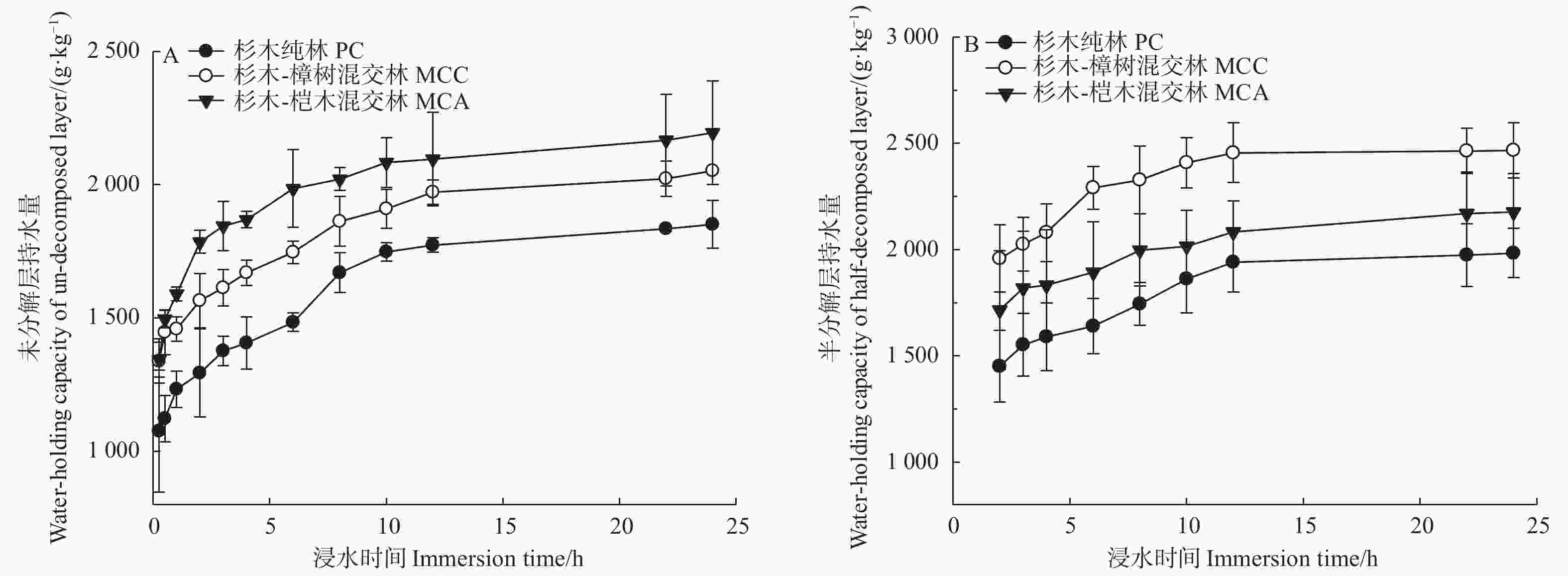
Figure 1. Relationship between water-holdingcapacity and immersion time of litters in different plantations
林分类型 Forest type 未分解层 Undecomposed layer 半分解层 Half-decomposed layer 方程 R2 方程 R2 杉木纯林 PC Q = 185.30lnt + 1241.4 0.928 0 Q = 192.74lnt + 1 369.8 0.969 7 杉木-樟树混交林 MCC Q = 162.25lnt + 1 504.6 0.942 3 Q = 211.62lnt + 1 854.5 0.965 0 杉木-桤木混交林 MCA Q = 193.45lnt + 1 623.0 0.963 3 Q = 204.90lnt + 1 552.3 0.994 4 Table 3. Simulated equation between water holding capacity of litter (Q) and immersion time (t)
-
由图2分析可知,杉木人工林凋落物吸水速率随浸水时间的延长而降低,其吸水速率在0~4 h内最大,4~10 h之间逐渐减缓,24 h基本趋于饱和。通过对不同林分类型杉木人工林各分解层凋落物吸水速率(V)与浸水时间(t)进行拟合发现,凋落物吸水速率随时间的动态变化符合幂函数方程V = ktn,式中:V为枯落物吸水速率,t为浸泡时间,k为方程系数,n为指数,并与实测值进行比较,发现不同林分类型杉木凋落物未分解层和半分解层持水速率的拟合度参数(R2)均大于0.99(表4),说明V、t两者之间存在较好的相关性(表4)。
林分类型 Forest type 未分解层 Undecomposed layer 半分解层 Half-decomposed layer 方程 R2 方程 R2 杉木纯林 PC V = 1230.1t-0.862 0.9985 V = 1358.0t-0.876 0.9994 杉木-樟树混交林 MCC V = 1498.7t-0.903 0.9995 V = 1826.1t-0.901 0.9990 杉木-桤木混交林 MCA V = 1608.7t-0.891 0.9994 V = 1534.5t-0.880 0.9996 Table 4. Simulated equation between water-absorption rate of litter (V) and immersion time (t)
-
通过分析图3(A)可知,不同林分类型杉木人工林未分解层最大持水率变化范围为183.50%~239.50%,其中杉木-桤木混交林显著高于杉木纯林(P < 0.05);半分解层持水率最大持水率变化范围为207.40%~256.03%,杉木-樟树混交林显著高于杉木纯林(P < 0.05)。由图3(B)可知,不同林分类型杉木人工林总最大持水量依次为:杉木-樟树混交林 > 杉木-桤木混交林 > 杉木纯林,其中杉木-樟树混交林、杉木-桤木混交林的最大持水量显著高于杉木纯林(P < 0.05),分别为杉木纯林的1.30倍和1.29倍;未分解层中,杉木-樟树混交林和杉木-桤木混交林的最大持水量均在8.00 t·hm−2以上,显著高于杉木纯林的5.54 t·hm−2(P < 0.05);半分解层中,最大持水量依次为:杉木-樟树混交林(11.00 t·hm−2) > 杉木-桤木混交林(10.39 t·hm−2) > 杉木纯林(9.82 t·hm−2),但3个不同林分类型杉木人工林间的差异不显著。
-
由图4(A)可知,不同林分类型杉木人工林凋落物有效拦蓄量不同,未分解层最大拦蓄率变化范围为152.33%~229.55%,其中杉木-樟树混交林、杉木-桤木混交林的最大拦蓄率显著高于杉木纯林(P < 0.05);半分解层最大拦蓄率变化范围为164.82%~228.00%,但不同林分类型杉木人工林间差异不显著。杉木凋落物总最大拦蓄量依次为:杉木-桤木混交林 > 杉木-樟树混交林 > 杉木纯林,而且针阔混交林显著高于针叶纯林(P < 0.05;图4(B))。未分解层最大拦蓄量变化范围为4.52~8.66 t·hm−2,杉木-桤木混交林和杉木-樟树混交林显著高于杉木纯林(P < 0.05);半分解层最大拦蓄量变化范围为8.10~9.47 t·hm−2,不同林分类型杉木人工林间差异不显著。
-
有效拦蓄量和有效拦蓄率可反映凋落物的实际拦蓄能力,评估凋落物的持水特性[22]。通过分析图5可知,杉木凋落物未分解层有效拦蓄率依次为:杉木-桤木混交林 > 杉木-樟树混交林 > 杉木纯林,针阔混交林显著高于杉木纯林(P < 0.05);半分解层有效拦蓄率依次为:杉木-樟树混交林 > 杉木-桤木混交林 > 杉木纯林,且不同林分类型杉木人工林间差异不显著。杉木凋落物总有效拦蓄量变化范围为10.26~14.75 t·hm−2,杉木-樟树混交林、杉木-桤木混交林显著高于杉木纯林(P < 0.05)。未分解层中杉木-桤木混交林、杉木-樟树混交林的有效拦蓄量分别为7.18、6.99 t·hm−2,显著高于杉木纯林(3.70 t·hm−2);半分解层中有效拦蓄量依次为:杉木-樟树混交林 > 杉木-桤木混交林 > 杉木纯林,但不同林分类型杉木人工林间差异不显著。
-
不同人工林的树种组成、林分结构、林分密度以及凋落物分解状况不同,从而决定了其凋落物蓄积量的差异。本研究发现,杉木-桤木混交林和杉木-樟树混交林凋落物的现存量显著高于杉木纯林,杨智杰等[23]在亚热带地区杉木纯林、杉木-木荷混交林中发现相似的规律,在相近林分密度下这可能与针阔混交形成的相对复杂的林冠层,提高植株对光和养分等资源的利用,促进植物地上部的生长有关。另一方面,Wang等[24]在该林地的研究发现,杉木与阔叶树混交后有助于改善林地土壤微生物特性和土壤肥力,而且可提高杉木植株与氮代谢相关酶的活性,促进氮素转化利用,利于植物生长发育[25]。从而导致混交林凋落物储量增加。
本研究表明,不同林分类型杉木人工林凋落物累积持水量、吸水速率和浸水时间拟合的方程为Q = a
$ \mathrm{l}\mathrm{n} $ t + b与V = ktn,拟合系数均大于0.90,可见其吸水动态变化过程与浸水时间紧密相关。降水前期由于凋落物比较干燥,表面水势低,从而导致瞬时吸水速率快速增加,无论未分解层还是半分解层,杉木人工林凋落物浸水前期吸水速率增加最快,特别是在浸水0.5 h内,凋落物持水量迅速上升,随着浸水时间的延长,3种林分类型杉木人工林凋落物的累积持水量不断增加,4~10 h内凋落物持水量增加速率减缓,并逐渐趋于饱和,达到最大持水量后则不再增加(图2),这与刘效东等[26]对鼎湖山人工林凋落物持水过程的研究结果相似,反映了在实际降水过程中凋落物对降雨的拦蓄过程。同时,在同一处理条件下,杉木凋落物半分解层的持水率和持水量均高于未分解层,可能由于半分解层结构疏松多孔、表面积增大,并且有少量腐殖质的形成[27],能够吸持更多的水分。本研究发现,针阔混交林未分解层和半分解层的最大持水率均高于杉木纯林,这主要与凋落物类型和吸水性能有关,杉木纯林凋落物以针叶为主,其叶片角质层发达韧性强,难分解的油脂含量高,亲水性差,导致其持水率低[28];而且,阔叶凋落物叶面积较大,与同等质量针叶凋落物相比可吸持更多的水分[29];再加上单位面积内针阔混交林的阔叶凋落物比重高于针叶纯林[30],因而与杉木纯林相比,杉木-樟树混交林和杉木-桤木混交林凋落物的持水率高。在本研究中,杉木-樟树混交林和杉木-桤木混交林凋落物最大持水量显著高于杉木纯林,表明针阔混交林凋落物潜在的持水能力高于杉木纯林,这可能与其现存量有关,凋落物最大持水量随其蓄积量的增大呈线性增加[29],杉木与阔叶树种混交导致的凋落物储量增加可提高其最大持水潜能;另外,半分解层持水率对凋落物持水能力也有关键贡献[31],3个林分的凋落物均以半分解层为主(表2),其中针阔混交林半分解层的最大持水率高于杉木纯林。所以,在相同条件下杉木-樟树混交林和杉木-桤木混交林凋落物能截持更多的水分。 -
本研究中,杉木-樟树混交林和杉木-桤木混交林各分解层凋落物的最大拦蓄率(量)和有效拦蓄率(量)均明显高于杉木纯林,总最大拦蓄量和有效拦蓄量显著高于杉木纯林,说明针阔混交林凋落物层拦持降水的能力要强于杉木纯林,这与杉木-樟树混交林、杉木-桤木混交林凋落物储量以及分解程度高于杉木纯林有关,且相关研究也表明物种多样性对凋落物分解具有正向“非累加效应”[32-33],混交林(杉木与阔叶树混交)的凋落物组成较纯林复杂,种类更趋多样化,从而在凋落物-土壤界面形成多样的微生态环境,促进微生物活动,加快凋落物的分解,进而增强凋落物层的持水能力[34]。此外,研究也发现杉木与阔叶树种混交后可改善土壤物理结构,有助于更好地发挥水土保持、涵养水源的功能[35]。
-
本研究通过对我国中亚热带不同林分类型杉木人工林凋落物现存量、持水特性的分析发现,与杉木纯林相比,杉木-桤木混交林和杉木-樟树混交林凋落物储量分别提高11.21%和11.84%,凋落物持水率增加,最大拦蓄量和有效拦蓄量均显著提高,说明与杉木纯林相比,针阔混交林凋落物层拦蓄降水的能力更强。基于针阔混交林凋落物对持水能力的显著增益效应,在现有退化人工林管理过程中,建议通过调节物种组成或引入混交树种(尤其是阔叶树种)等合理的经营措施,实现其生态水文功能的提升,同时在以后的人工林经营管理和植被恢复过程中,应尽可能避免营造纯林,优先考虑针阔树种混交的多树种配置模式。
致谢:感谢中国科学院会同森林生态站对本研究野外调查及采样等工作的大力支持。
Hydrological Effects of Litters in Different Types of Cunninghamia lanceolata Plantations in Huitong of Hunan, China
- Received Date: 2021-03-28
- Accepted Date: 2021-06-11
- Available Online: 2021-12-20
Abstract:

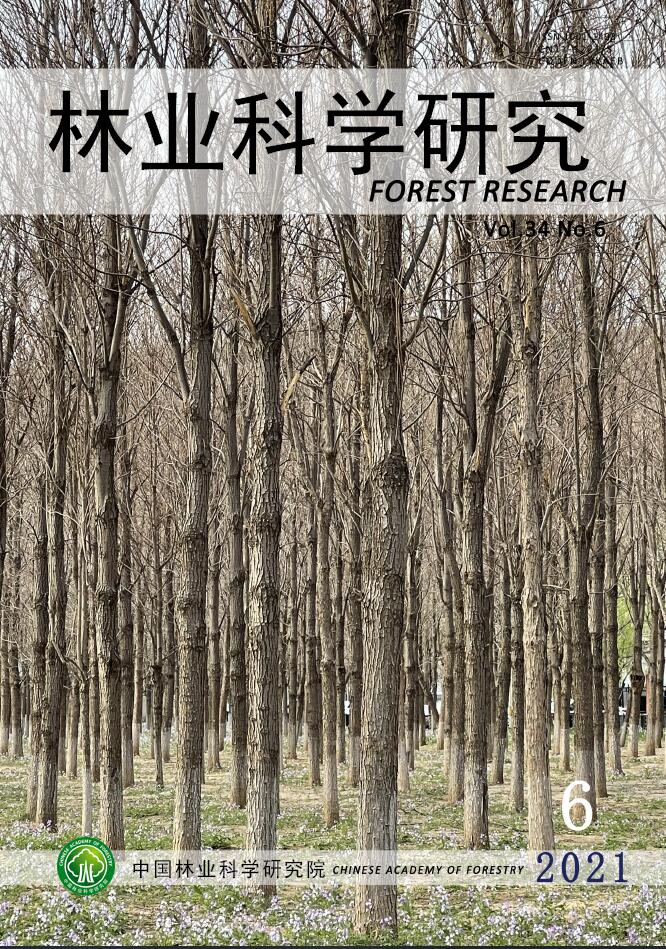





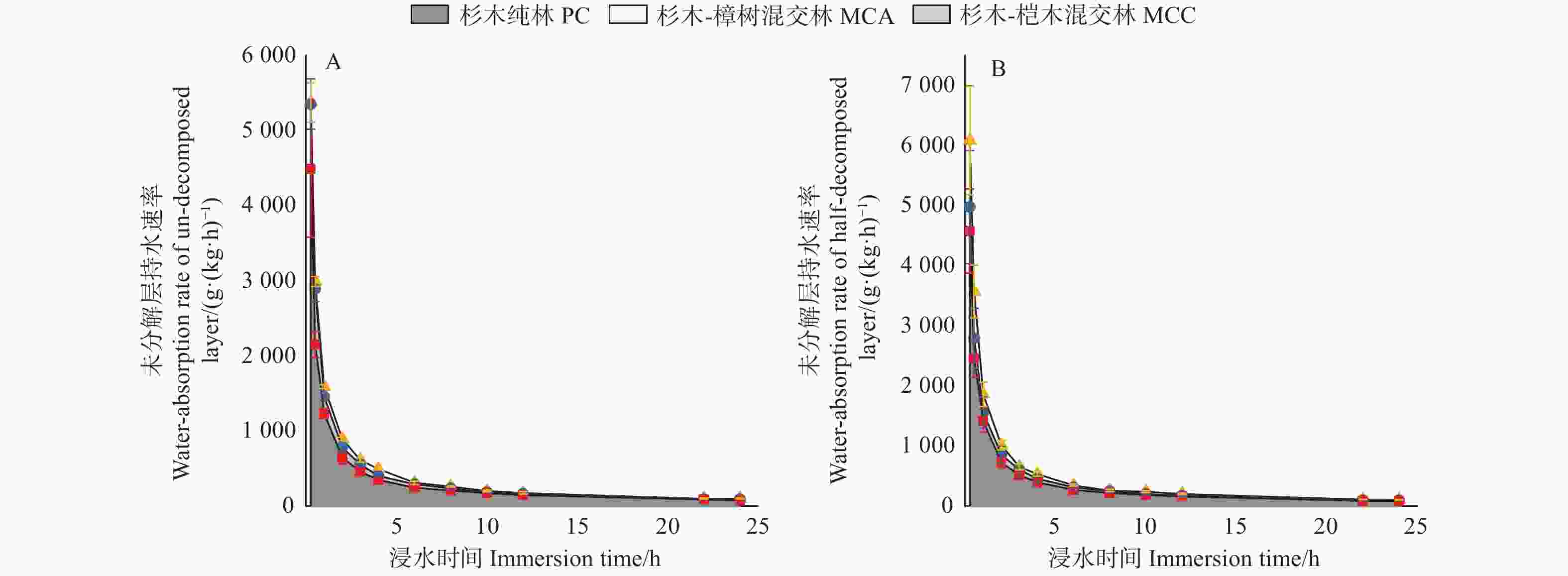

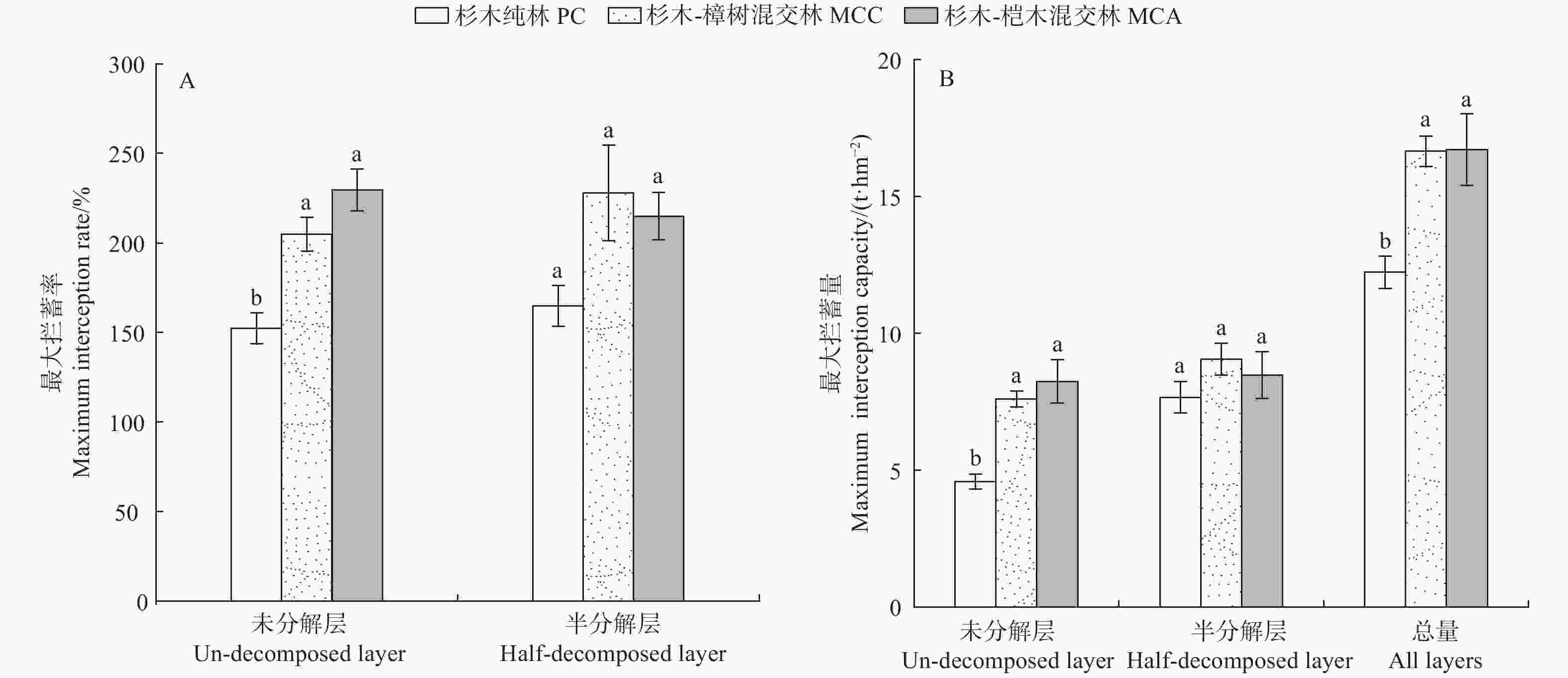


 DownLoad:
DownLoad:

